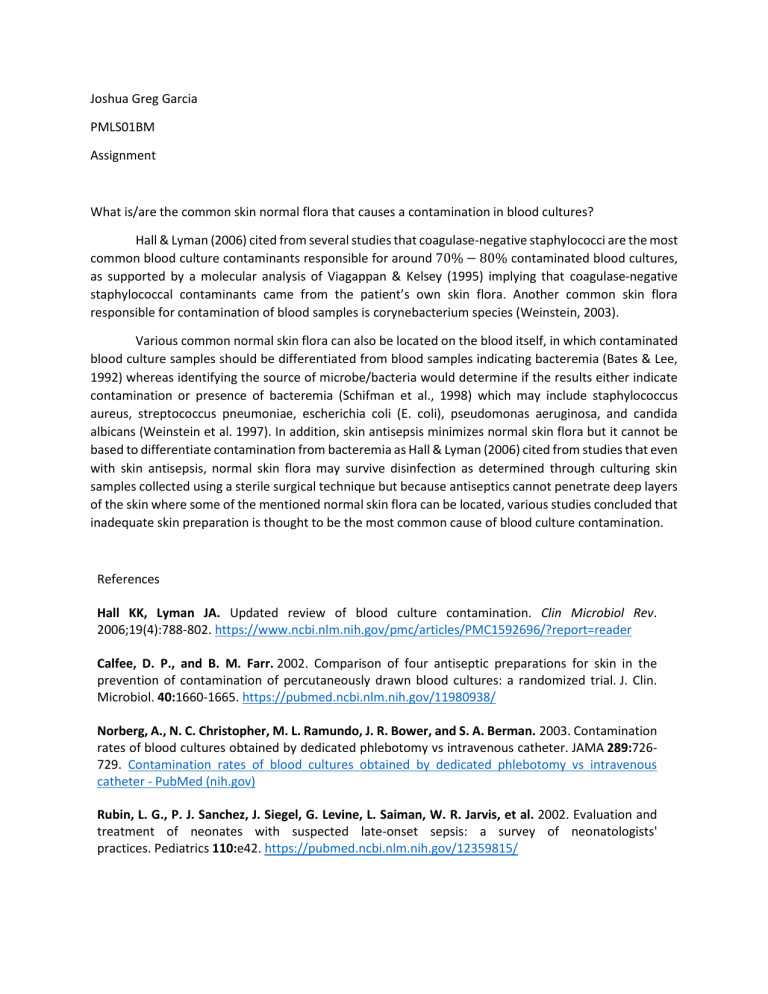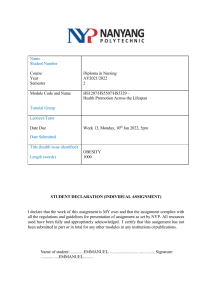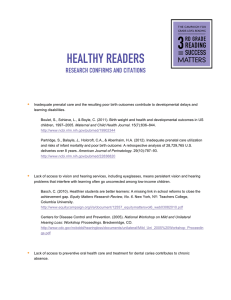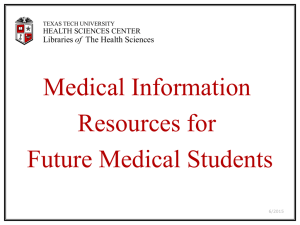
Joshua Greg Garcia PMLS01BM Assignment What is/are the common skin normal flora that causes a contamination in blood cultures? Hall & Lyman (2006) cited from several studies that coagulase-negative staphylococci are the most common blood culture contaminants responsible for around 70% − 80% contaminated blood cultures, as supported by a molecular analysis of Viagappan & Kelsey (1995) implying that coagulase-negative staphylococcal contaminants came from the patient’s own skin flora. Another common skin flora responsible for contamination of blood samples is corynebacterium species (Weinstein, 2003). Various common normal skin flora can also be located on the blood itself, in which contaminated blood culture samples should be differentiated from blood samples indicating bacteremia (Bates & Lee, 1992) whereas identifying the source of microbe/bacteria would determine if the results either indicate contamination or presence of bacteremia (Schifman et al., 1998) which may include staphylococcus aureus, streptococcus pneumoniae, escherichia coli (E. coli), pseudomonas aeruginosa, and candida albicans (Weinstein et al. 1997). In addition, skin antisepsis minimizes normal skin flora but it cannot be based to differentiate contamination from bacteremia as Hall & Lyman (2006) cited from studies that even with skin antisepsis, normal skin flora may survive disinfection as determined through culturing skin samples collected using a sterile surgical technique but because antiseptics cannot penetrate deep layers of the skin where some of the mentioned normal skin flora can be located, various studies concluded that inadequate skin preparation is thought to be the most common cause of blood culture contamination. References Hall KK, Lyman JA. Updated review of blood culture contamination. Clin Microbiol Rev. 2006;19(4):788-802. https://www.ncbi.nlm.nih.gov/pmc/articles/PMC1592696/?report=reader Calfee, D. P., and B. M. Farr. 2002. Comparison of four antiseptic preparations for skin in the prevention of contamination of percutaneously drawn blood cultures: a randomized trial. J. Clin. Microbiol. 40:1660-1665. https://pubmed.ncbi.nlm.nih.gov/11980938/ Norberg, A., N. C. Christopher, M. L. Ramundo, J. R. Bower, and S. A. Berman. 2003. Contamination rates of blood cultures obtained by dedicated phlebotomy vs intravenous catheter. JAMA 289:726729. Contamination rates of blood cultures obtained by dedicated phlebotomy vs intravenous catheter - PubMed (nih.gov) Rubin, L. G., P. J. Sanchez, J. Siegel, G. Levine, L. Saiman, W. R. Jarvis, et al. 2002. Evaluation and treatment of neonates with suspected late-onset sepsis: a survey of neonatologists' practices. Pediatrics 110:e42. https://pubmed.ncbi.nlm.nih.gov/12359815/ Schifman, R. B., C. L. Strand, F. A. Meier, and P. J. Howanitz. 1998. Blood culture contamination: a College of American Pathologists Q-Probes study involving 640 institutions and 497134 specimens from adult patients. Arch. Pathol. Lab. Med. 122:216-221. https://pubmed.ncbi.nlm.nih.gov/9823858/ Souvenir, D., D. E. Anderson, Jr., S. Palpant, H. Mroch, S. Askin, J. Anderson, J. Claridge, J. Eiland, C. Malone, M. W. Garrison, P. Watson, and D. M. Campbell. 1998. Blood cultures positive for coagulase-negative staphylococci: antisepsis, pseudobacteremia, and therapy of patients. J. Clin. Microbiol. 36:1923-1926. https://pubmed.ncbi.nlm.nih.gov/9650937/ Viagappan, M., and M. C. Kelsey. 1995. The origin of coagulase-negative staphylococci isolated from blood cultures. J. Hosp. Infect. 30:217-223. https://pubmed.ncbi.nlm.nih.gov/8522778/ Bates, D. W., and T. H. Lee. 1992. Rapid classification of positive blood cultures. Prospective validation of a multivariate algorithm. JAMA 267:1962-1966. https://pubmed.ncbi.nlm.nih.gov/1548830/ Schifman, R. B., C. L. Strand, F. A. Meier, and P. J. Howanitz. 1998. Blood culture contamination: a College of American Pathologists Q-Probes study involving 640 institutions and 497134 specimens from adult patients. Arch. Pathol. Lab. Med. 122:216-221. https://pubmed.ncbi.nlm.nih.gov/9823858/ Weinstein, M. P. 2003. Blood culture contamination: persisting problems and partial progress. J. Clin. Microbiol. 41:2275-2278. https://pubmed.ncbi.nlm.nih.gov/12791835/ Brown, E., R. P. Wenzel, and J. O. Hendley. 1989. Exploration of the microbial anatomy of normal human skin by using plasmid profiles of coagulase-negative staphylococci: search for the reservoir of resident skin flora. J. Infect. Dis. 160:644-650. https://pubmed.ncbi.nlm.nih.gov/2794559/ Selwyn, S., and H. Ellis. 1972. Skin bacteria and skin disinfection reconsidered. Br. Med. J. i:136-140. https://pubmed.ncbi.nlm.nih.gov/5007838/ Chandrasekar, P. H., and W. J. Brown. 1994. Clinical issues of blood cultures. Arch. Intern. Med. 154:841-849. https://pubmed.ncbi.nlm.nih.gov/8154947/ Mylotte, J. M., and A. Tayara. 2000. Blood cultures: clinical aspects and controversies. Eur. J. Clin. Microbiol. Infect. Dis. 19:157-163. https://pubmed.ncbi.nlm.nih.gov/10795587/ Washington, J. A., II, and D. M. Ilstrup. 1986. Blood cultures: issues and controversies. Rev. Infect. Dis. 8:792-802. https://pubmed.ncbi.nlm.nih.gov/3538319/





